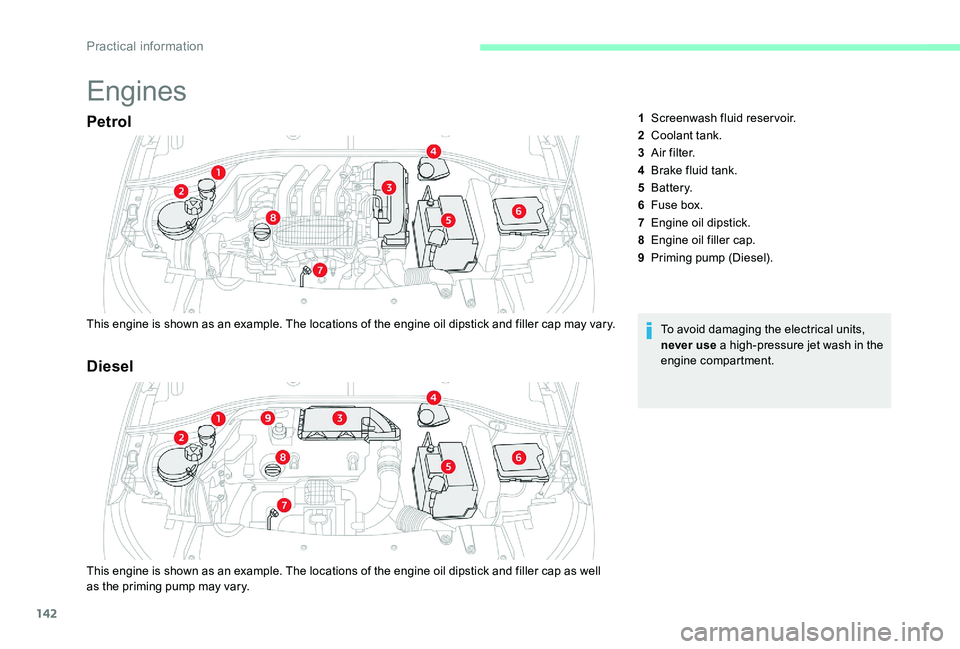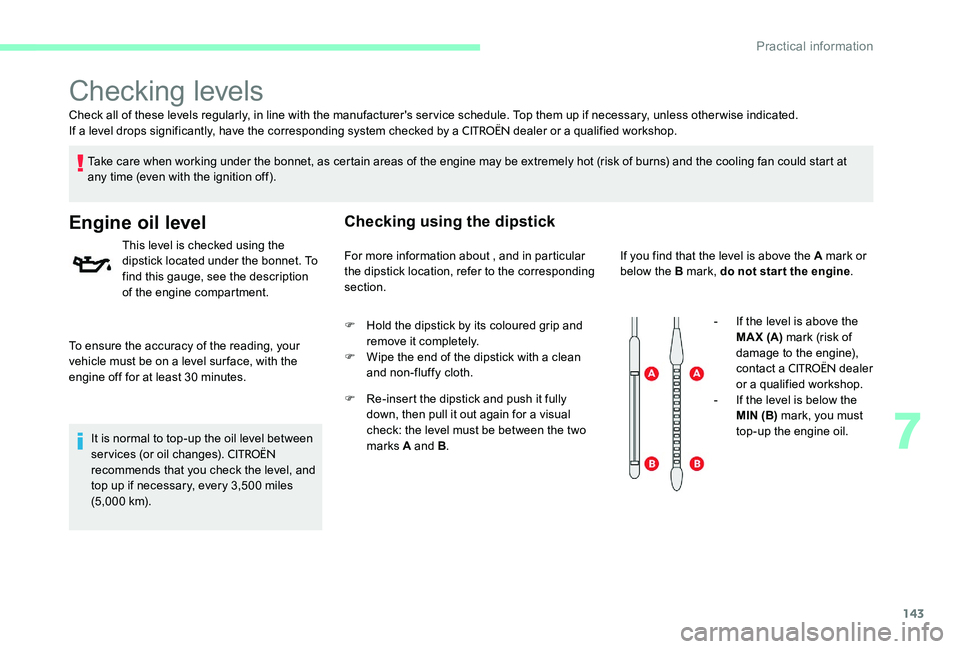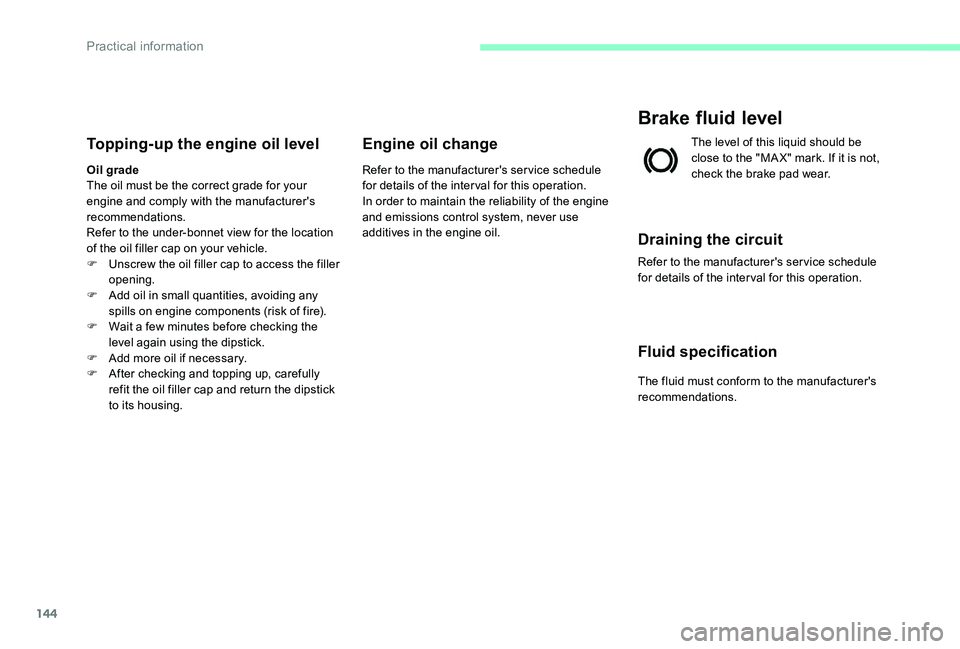oil CITROEN C-ELYSÉE 2017 Handbook (in English)
[x] Cancel search | Manufacturer: CITROEN, Model Year: 2017, Model line: C-ELYSÉE, Model: CITROEN C-ELYSÉE 2017Pages: 306, PDF Size: 9.34 MB
Page 10 of 306

8
Maintenance - Technical data
7
Petrol weight
1
80
Diesel weight
1
81
8
Identification elements
1
83
Dimensions
1
82
1
Checking the levels
1
43 -145
-
oil
-
b
rake fluid
-
coolant
-
s
creenwash fluid
-
a
dditive (diesel with particle filter)
Checking the components
1
46-147
-
battery
-
a
ir/passenger compartment filter
-
o
il filter
-
p
article filter (diesel)
-
b
rake pads/discs
2
Running out of Diesel fuel
1
48
AdBlue
® and SCR
(Diesel BlueHDi) system 1 32-135
3
Battery
1
72-176
Load reduction, economy mode
1
37
4
Engine compartment fuses
1
67-171
5
Opening bonnet
1
41
Under bonnet layouts, petrol
1
42
Under bonnet layout, Diesel
1
42
Petrol engines
1
80
Diesel engine
1
81
6
Changing bulbs
1
61-166
-
front
-
rear
Over view
Page 12 of 306

10
Limit the causes of
excess consumption
Spread loads throughout the vehicle; place
the heaviest items in the bottom of the boot,
as close as possible to the rear seats.
Limit the loads carried in the vehicle and
reduce wind resistance (roof bars, roof rack,
bicycle carrier, trailer...). Preferably use a roof
box.
Remove roof bars and roof racks after use.
At the end of winter, remove snow tyres and
refit your summer tyres.
Observe the recommendations
on maintenance
Check the tyre pressures regularly, when cold,
referring to the label in the door aperture,
driver's side.
Carry out this check in particular:
-
b
efore a long journey,
-
a
t each change of season,
-
a
fter a long period out of use.
Don't forget the spare wheel and the tyres on
any trailer or caravan. Have your vehicle serviced regularly (engine
oil, oil filter, air filter, etc.) and observe the
schedule of operations recommended by the
manufacturer.
When filling the tank, do not continue after the
3
rd cut-off of the nozzle to avoid over flow.
At the wheel of your new vehicle, it is only
after the first 1,800 miles (3,000 kilometres)
that you will see the fuel consumption settle
down to a consistent average.
Eco-driving
Page 15 of 306

13
Warning / indicator lampStateCause Action / Observations
STOP Fixed, associated
with another warning
light. It is associated with the engine
oil pressure or the engine
coolant temperature. You must stop as soon as it is safe to do so.
Park, switch off the ignition and call a
CITROËN dealer
or qualified workshop.
Parking brake Continuous. The parking brake is applied or
not properly released. Release the parking brake to switch off the warning
light, keeping your foot on the brake pedal.
Observe the safety recommendations.
For more information on the Parking brake
, refer to
the corresponding section.
Brakes Fixed. The brake fluid level has
dropped significantly. You must stop as soon as it is safe to do so.
Top-up with brake fluid listed by
CITROËN.
If the problem persists, have the system checked by a
CITROËN dealer or a qualified workshop.
Fixed, associated
with the ABS warning
light. The electronic brake force
distribution (EBFD) system has
a fault. You must stop as soon as it is safe to do so.
Have it checked by a
CITROËN dealer or a qualified
workshop.
1
Instruments
Page 16 of 306

14
Warning / indicator lampStateCause Action / Observations
Driver's seat
belt not fastened
or unfastened
/ Front
passenger's
seat belt
unfastenedContinuous or
flashing accompanied
by an increasing
audible signal.The driver has not fastened or
has unfastened his/her seat belt.
The front passenger has
unfastened his/her seat belt. Pull the strap then insert the tongue in the buckle.
Battery charge Continuous. The battery charging circuit has
a fault (dirty or loose terminals,
slack or cut alternator belt, ...). The warning light should go off when the engine is
started.
If it does not go off, contact a
CITROËN dealer or a
qualified workshop.
Engine oil
pressure Continuous.
There is a fault with the engine
lubrication system. You must stop as soon as it is safe to do so.
Park, switch off the ignition and contact a
CITROËN
dealer or a qualified workshop.
Instruments
Page 27 of 306

25
Service indicator
For BlueHDi Diesel versions, the degree
of deterioration of the engine oil is also
taken into account (depending on the
country of sale).
When the ignition is switched on, no service
information appears in the screen.
More than 1,800 miles (3,000 km)
remain before the next service is due
Between 600 miles (1,000 km) and 1,800 miles
(3,000 km) remain before the next service is due
The spanner symbolising the service
operations illuminates for 5 seconds when the
ignition is switched on. The distance recorder
display line indicates the distance remaining
before the next service is due.
Example: You have 1,700 miles (2,800 km) left
before the next service is due.
For 5 seconds after the ignition is switched on,
the screen indicates:
Less than 600 miles (1,000 km) remain
before the next service is due
Example: You have 560 miles (900 km) left
before the next service is due.
For 5 seconds after the ignition is switched on,
the screen indicates:
5 seconds after the ignition is switched on,
the total distance recorder resumes its normal
operation. The servicing spanner remains on
as a reminder that a service is required soon.
System which informs the driver when the
next service is due, in accordance with the
manufacturer's servicing schedule.
The point at which the service is due is
calculated from the last reset of the service
indicator, according to the mileage covered and
the time elapsed since the last service.
5 seconds after the ignition is switched on,
the spanner goes off
; the distance recorder
resumes its normal operation. The screen then
indicates the total distance.
1
Instruments
Page 28 of 306

26
The servicing interval has been exceededFor 5 seconds after the ignition is switched
on, the spanner flashes to indicate that
the service must be carried out as soon as
possible.
Example: the service is overdue by 186 miles
(3 0 0 k m).
For 5 seconds after the ignition is switched on,
the screen indicates:
5 seconds after the ignition is switched on,
the total distance recorder resumes its normal
operation. The spanner remains on .
For BlueHDi Diesel versions, this alert
is also accompanied by the continuous
illumination of the Service warning light
when the ignition is switched on. The remaining mileage may be weighted
by time according to the driver’s driving
habits.
The spanner may therefore also come
on if you have exceeded the period
since the last service, as indicated in the
manufacturer's service schedule.
For BlueHDi Diesel versions, the spanner
may also come on early, depending on the
degree of deterioration of the engine oil
(depending on the country of sale).
The degree of deterioration of the engine
oil depends on the driving conditions in
which the vehicle is used.Resetting the service indicator
The service indicator must be reset after each
service.
The procedure for resetting to zero is as
follows:
F
S
witch off the ignition.
F
P
ress the trip distance recorder reset
button and keep it pressed.
F
S
witch the ignition on; the distance
recorder display starts a countdown.
F
R
elease the button when =0 is displayed;
the spanner disappears.
Following this operation, if you wish to
disconnect the battery, lock the vehicle
and wait at least five minutes for the zero
reset to be taken into account.
Retrieving the service
information
You can access the service information at any
time.
F
P
ress the trip distance recorder reset
button. The service information is
displayed for a few seconds, then
disappears.
Instruments
Page 133 of 306

131
Fuel used for petrol engines
The petrol engines are compatible with biofuels
that conform to current and future European
standards and can be obtained from filling
stations:Petrol that meets the EN228 standard,
mixed with a bio-fuel meeting the
EN15376 standard.
The only petrol additives authorised for
use are those that meet the B715001
standard.
Fuel used for Diesel
engines
The Diesel engines are compatible with
biofuels that conform to current and future
European standards and can be obtained from
filling stations: For more information, contact a CITROËN
dealer or a qualified workshop.
The use of any other type of (bio)fuel
(vegetable or animal oils, pure or diluted,
domestic fuel...) is strictly prohibited (risk
of damage to the engine and fuel system). The only Diesel additives authorised for
use are those that meet the B715000
standard.
The use of B20 or B30 fuel that meets
the standard EN16709 is possible
with your Diesel engine. However, this
use, even occasional, requires strict
application of the special servicing
conditions referred to as "Arduous
conditions". Diesel fuel that meets standard
EN16734 mixed with a biofuel that
meets standard EN14214 (possibly
containing up to 10% Fatty Acid Methyl
Ester),
Paraffinic Diesel fuel that meets
standard EN15940 mixed with a biofuel
that meets standard EN14214 (possibly
containing up to 7 % Fatty Acid Methyl
Ester).
Diesel fuel that meets standard
EN590 mixed with a biofuel that meets
standard EN14214 (possibly containing
up to 7% Fatty Acid Methyl Ester),Travelling abroad
Certain fuels could damage the engine of your
vehicle.
In certain countries, the use of a particular
fuel may be required (specific octane rating,
specific sales name…) to ensure correct
operation of the engine.
Far any additional information, contact the
dealer.
Compatibility of
fuels
Diesel at low temperature
At temperatures below 0°C (+32°F), the
formation of paraffins in summer-type diesel
fuels could entail an abnormal operation
of the fuel supply circuit. To avoid this, we
recommend using winter-type diesel fuel and
keeping the fuel tank more than 50% full.
If, despite this, at temperatures below -15°C
(+5°F) the engine has problems starting,
just leave the vehicle in a garage or heated
workshop for a little while.
7
Practical information
Page 144 of 306

142
Engines
Petrol
This engine is shown as an example. The locations of the engine oil dipstick and filler cap may vary.To avoid damaging the electrical units,
never use a high-pressure jet wash in the
engine compartment.
Diesel
This engine is shown as an example. The locations of the engine oil dipstick and filler cap as well
as the priming pump may vary.1
Screenwash fluid reservoir.
2 Coolant tank.
3 A i r f i l t e r.
4 Brake fluid tank.
5 Battery.
6 Fuse box.
7 Engine oil dipstick.
8 Engine oil filler cap.
9 Priming pump (Diesel).
Practical information
Page 145 of 306

143
Check all of these levels regularly, in line with the manufacturer's service schedule. Top them up if necessary, unless other wise indicated.
If a level drops significantly, have the corresponding system checked by a CITROËN dealer or a qualified workshop.
Take care when working under the bonnet, as certain areas of the engine may be extremely hot (risk of burns) and the cooling fan could start at
any time (even with the ignition off).
Checking levels
Engine oil level
To ensure the accuracy of the reading, your
vehicle must be on a level sur face, with the
engine off for at least 30 minutes.
It is normal to top-up the oil level between
services (or oil changes).
CITROËN
recommends that you check the level, and
top up if necessary, every 3,500 miles
(5,000 km). This level is checked using the
dipstick located under the bonnet. To
find this gauge, see the description
of the engine compartment.
Checking using the dipstick
For more information about , and in particular
the dipstick location, refer to the corresponding
section.
F
H
old the dipstick by its coloured grip and
remove it completely.
F
W
ipe the end of the dipstick with a clean
and non-fluffy cloth.
F
R
e-insert the dipstick and push it fully
down, then pull it out again for a visual
check: the level must be between the two
marks A and B . If you find that the level is above the A mark or
below the B mark, do not star t the engine
.
-
I
f the level is above the
MA X (A) mark (risk of
damage to the engine),
contact a
CITROËN dealer
or a qualified workshop.
-
I
f the level is below the
MIN (B) mark, you must
top-up the engine oil.
7
Practical information
Page 146 of 306

144
Topping-up the engine oil level
Oil grade
The oil must be the correct grade for your
engine and comply with the manufacturer's
recommendations.
Refer to the under-bonnet view for the location
of the oil filler cap on your vehicle.
F
U
nscrew the oil filler cap to access the filler
opening.
F
A
dd oil in small quantities, avoiding any
spills on engine components (risk of fire).
F
W
ait a few minutes before checking the
level again using the dipstick.
F
A
dd more oil if necessary.
F
A
fter checking and topping up, carefully
refit the oil filler cap and return the dipstick
to its housing.
Engine oil change
Refer to the manufacturer's service schedule
for details of the interval for this operation.
In order to maintain the reliability of the engine
and emissions control system, never use
additives in the engine oil.
Brake fluid level
The level of this liquid should be
close to the "MA X" mark. If it is not,
check the brake pad wear.
Draining the circuit
Refer to the manufacturer's service schedule
for details of the interval for this operation.
Fluid specification
The fluid must conform to the manufacturer's
recommendations.
Practical information